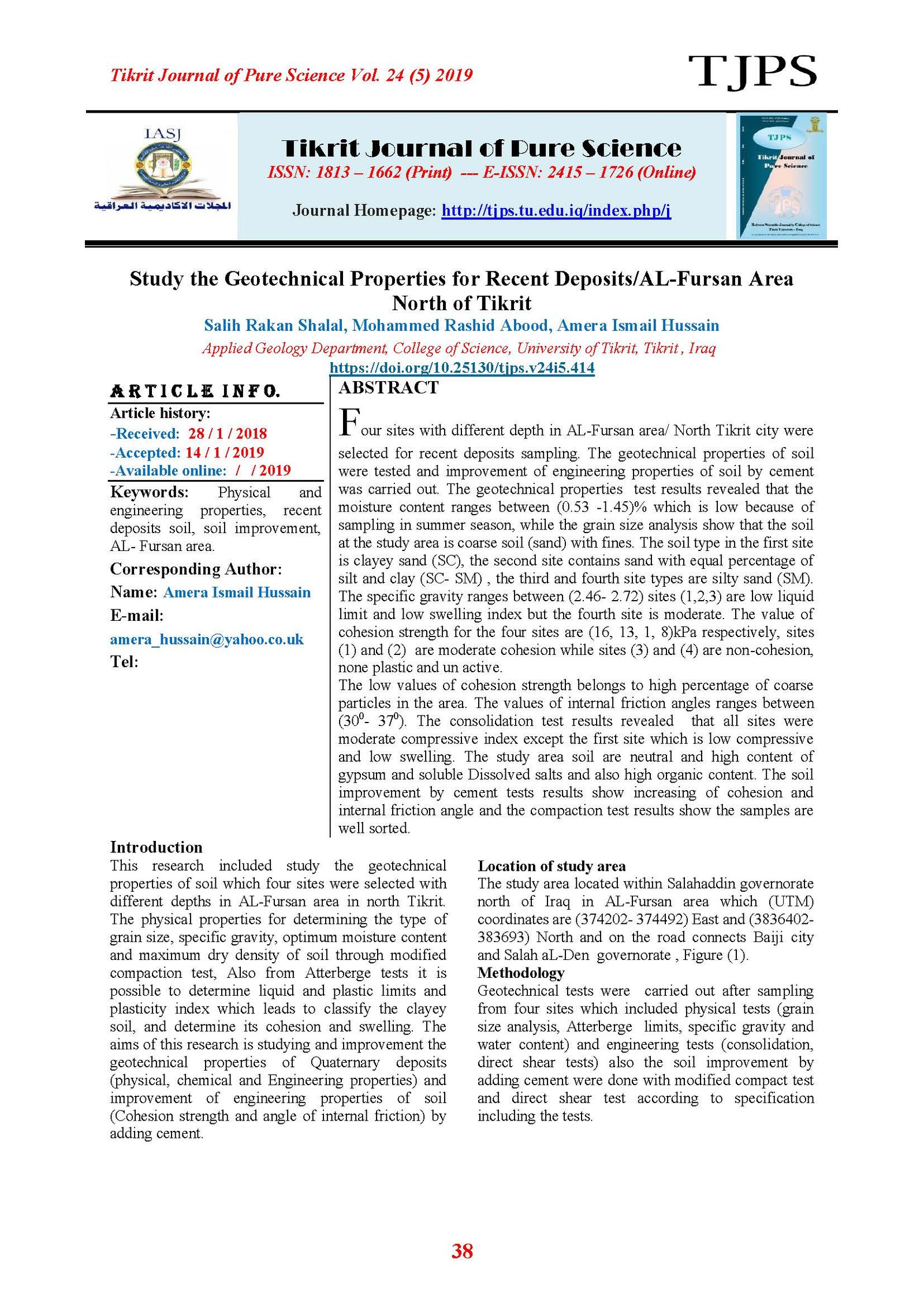Study the Geotechnical Properties for Recent Deposits/AL-Fursan Area North of Tikrit
Main Article Content
Abstract
Four sites with different depth in AL-Fursan area/ North Tikrit city were selected for recent deposits sampling. The geotechnical properties of soil were tested and improvement of engineering properties of soil by cement was carried out. The geotechnical properties test results revealed that the moisture content ranges between (0.53 -1.45)% which is low because of sampling in summer season, while the grain size analysis show that the soil at the study area is coarse soil (sand) with fines. The soil type in the first site is clayey sand (SC), the second site contains sand with equal percentage of silt and clay (SC- SM) , the third and fourth site types are silty sand (SM). The specific gravity ranges between (2.46- 2.72) sites (1,2,3) are low liquid limit and low swelling index but the fourth site is moderate. The value of cohesion strength for the four sites are (16, 13, 1, 8)kPa respectively, sites (1) and (2) are moderate cohesion while sites (3) and (4) are non-cohesion, none plastic and un active.
The low values of cohesion strength belongs to high percentage of coarse particles in the area. The values of internal friction angles ranges between (300- 370). The consolidation test results revealed that all sites were moderate compressive index except the first site which is low compressive and low swelling. The study area soil are neutral and high content of gypsum and soluble Dissolved salts and also high organic content. The soil improvement by cement tests results show increasing of cohesion and internal friction angle and the compaction test results show the samples are well sorted.
Article Details

This work is licensed under a Creative Commons Attribution 4.0 International License.
Tikrit Journal of Pure Science is licensed under the Creative Commons Attribution 4.0 International License, which allows users to copy, create extracts, abstracts, and new works from the article, alter and revise the article, and make commercial use of the article (including reuse and/or resale of the article by commercial entities), provided the user gives appropriate credit (with a link to the formal publication through the relevant DOI), provides a link to the license, indicates if changes were made, and the licensor is not represented as endorsing the use made of the work. The authors hold the copyright for their published work on the Tikrit J. Pure Sci. website, while Tikrit J. Pure Sci. is responsible for appreciate citation of their work, which is released under CC-BY-4.0, enabling the unrestricted use, distribution, and reproduction of an article in any medium, provided that the original work is properly cited.
References
[1] Al-Sayab, A. Sh., Al-Ansari, N.A.,Al-Rawi, D.Y., Al-Jassim, J.A. Al-Omari, F.S. and Al-Sheikh, Z. (1982), "Geology of Iraq, Dar Al Kutb for Printing and Publishing, Mosul, 280pp.
[2] Buday, T.G, (1980) “The regional geology of Iraq, Stratigraphy and Paleogeography". Geol. Surv. and Min. Inv. Baghdad,445pp.
[3] ASTM D2216-10, 2004: Standard Test Methods for Laboratory Determination of Water (Moisture) Content of Soil and Rock by Mass.
[4] ASTM D854-14,2014: Standard Test Methods for Specific Gravity of Soil Solids by Water Pycnometer1, American Society for Testing Materials, West Conshohocken, Pennsylvania.
[5] ASTM, D 422-63 .,(2004): Standard Test Method for Particle-Size Analysis of Soils .
[6] Fatuhie, Z. R., Al-Jassar, S. H., Kanana, M. and Muskour, M., 1990, Engineering Geology and On-Site Investigation, Mosul University, Dar Books for Printing and Publishing, Mosul, 252pp.
[7] ASTM, D 4318-00., (2004): Standard Test Methods for Liquid Limit, Plastic Limit, and Plasticity Index of Soils .
[8] Kerbs, R. D., and Walker, R. D., 1971, High way Material, 1st ed., McGraw Hill Book Inc, USA. 428p.
[9] Terzaghi, K. and Peck, R. B. 1967: Soil Mechanics in Engineering Practice, 2nd edn. john wiley and sons.NewYork.729p
[10] ASTM- 2435 (2004): Standard Test Methods for One-Dimensional Swell or Settement Potential of Cohesive Soils,7p.
[11] Snethen, D. R., 1975, “A Review of Engineering Experiences With Expansive Soils in Highway Subgrades”, Report No. FHWA-RD-75-48
[12] Sowers G. B. and Sowers, G. F. (1960): Introductory Soil Mechanics and Foundation. MacMillan Co, NY
[13] ASTM D3080-11, 2011: Standard Test Method for Direct Shear Test of Soils Under Consolidated Drained Conditions.
[14]ASTM-D,698.M(2004) Sandard test method for laboratory compaction characterization of soil.
[15] Hussain, A.I. and Sulaiman, R.M. (2005) The Engineering Properties of Soil and methods of measurement, Tikrit University,195pp.
